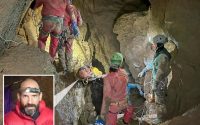Venus experienced recent volcanic activity: NASA
It has long been assumed that Venus is a dying planet, but new findings have shown promising signs of activity.
New evidence suggests that there is geological activity happening on Venus.
The discovery has been made thanks to some old images of Venus, which scientists claim show proof of recent volcanic activity.
NASA’s Magellan spacecraft visited Venus in the 1990s and captured images.
The stunning images reveal that over eight months, a volcanic vent increased in size and changed shape.
NASA published these new findings on its official website.
Robert Herrick, a research professor at the University of Alaska Fairbanks and member of the science team who led the search for the archival data, admitted he was surprised to make such a big discovery.

“NASA’s selection of the VERITAS mission inspired me to look for recent volcanic activity in Magellan data,” he said.
“I didn’t really expect to be successful, but after about 200 hours of manually comparing the images of different Magellan orbits, I saw two images of the same region taken eight months apart exhibiting telltale geological changes caused by an eruption.”
Prof Herrick also revealed how he was able to tell activity had occurred based on some images from 30 years ago.

“Only a couple of the simulations matched the imagery, and the most likely scenario is that volcanic activity occurred on Venus’ surface during Magellan’s mission,” he said.
“While this is just one data point for an entire planet, it confirms there is modern geological activity.”
This is particularly interesting because Venus is Earth’s closest planetary neighbor.
Venus has also been dubbed Earth’s “sister planet” because they are similar in size and mass.
Venus is the second planet from the Sun while Earth is the third.
To put that in perspective, it would still take almost four months to travel from Earth to Venus.


